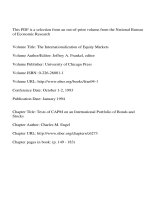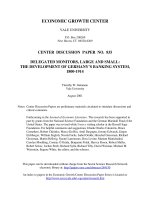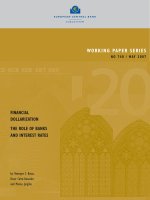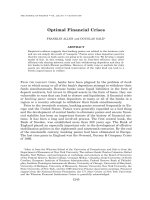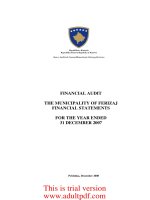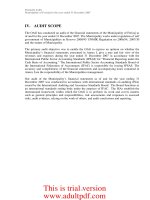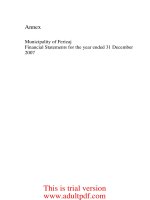hoffman - surviving large losses; financial crises, the middle class, and the development of capital markets (2007)
Bạn đang xem bản rút gọn của tài liệu. Xem và tải ngay bản đầy đủ của tài liệu tại đây (1.29 MB, 272 trang )
Surviving Large Losses
S urviving Large Losses
FINANCIAL CRISES,
theMIDDLE CLASS,
and the DEVELOPMENT OF
CAPITAL MARKETS
Philip T. Hoffman
Gilles Postel-Vinay
Jean-Laurent Rosenthal
THE BELKNAP PRESS OF
HARVARD UNIVERSITY PRESS
Cambridge, Massachusetts
London, England
2007
Copyright © 2007 by the President and Fellows of Harvard College
All rights reserved
Printed in the United States of America
Cataloging-in-Publication Data available from the Library of Congress
Library of Congress catalog card number: 2006041275
ISBN-13: 978-0-674-02469-4 (alk. paper)
ISBN-10: 0-674-02469-9 (alk. paper)
Contents
Acknowledgments vii
Introduction 1
1. The Political Economy of Financial Crises 9
2. Information and Crises 31
3. Crises and the Middle Class 64
4. What Happens after Crises 101
5. Financial Intermediaries
and the Demand for Change 128
6. Governments and the Demand for Reform 157
Conclusion: The Lessons of History 194
Notes 225
References 239
Index 255
Acknowledgments
WE OWE AN ENORMOUS DEBT of gratitude to the institu-
tions that have supported our work and to the individuals who have
shared data, read what we have written, or offered us suggestions, ad-
vice, and criticisms. The institutions we wish to thank are the Cali-
fornia Institute of Technology and the John Simon Guggenheim
Foundation, for Hoffman; the Ecole des Hautes Etudes en Sciences
Sociales and the Institut National de la Recherche Agronomique, for
Postel-Vinay; and the Ecole des Hautes Etudes en Sciences Sociales,
the Ecole d’Economie de Paris, the Institut National de la Recherche
Agronomique, the John Simon Guggenheim Foundation, and the
University of California, Los Angeles, for Rosenthal. The individuals
to whom we are grateful include Mike Alvarez, Peter Bossaerts,
Jerome Bourdieu, Federico Echenique, Mordechai Feingold, Oscar
Gelderblom, Peter Gourevitch, Rod Kiewiet, Morgan Kousser, Na-
omi Lamoreaux, John Ledyard, Juliette Levi, Mark H. Madden,
Mark Rubenstein, Joseph Ryan, Kenneth Sokoloff, Akiko Suwa-
Eisenmann, R. Bin Wong, the Harvard University Press readers, and
especially Ann Hawthorne and Michael Aronson.
Le souvenir se présente à l’imparfait
Memory appears in the imperfect
—Francis Ponge, “Proèmes”
Introduction
HAVE YOU EVER WORRIED about the chances of a financial
disaster? Ever lost sleep over the possibility that your savings might
be gutted or your investments wiped out? Maybe you haven’t, be-
cause you are smart and savvy and have taken all sorts of steps to
defend yourself. Or maybe you are simply confident that modern
financial markets and government safeguards will always protect you.
But that protection doesn’t always work. Just ask Sandra Stone or
any one of the 20,000 or so other former employees of the Enron
Corporation whose pensions and savings were swallowed up when
their company went bankrupt late in 2001. Stone could have been
speaking for any one of her colleagues when she exclaimed: “I’m
livid, absolutely livid. I have lost my entire friggin’ retirement to these
people.”
1
No one wants to end up like Sandra and her coworkers. But the
sad fact is that she and her colleagues are by no means alone. Finan-
cial crises have struck repeatedly for centuries, leaving countless vic-
tims in their wake. Some of those victims were so noted for their
brilliance that we think they surely ought to have known better: Isaac
Newton sustained losses in an early English stock market bubble;
1
Voltaire, who had speculated to great advantage, dropped a sizable
chunk of his profits in a government debt default; and the brilliant
economist Irving Fisher saw his fortune annihilated in the Great
Crash of 1929.
2
If geniuses like these proved so vulnerable, what’s the
outlook for everyone else?
Hindsight often persuades us that the crises could easily have been
avoided. Yet the truth is that financial crises are virtually inevitable,
like earthquakes or hurricanes. Indeed, despite all the reforms they
have inspired, they continue to batter us, as we can see from the col-
lapse of the Asian banks and stock markets, the bursting of the Inter-
net bubble and subsequent wave of bankruptcies, and the corporate
scandals of the late 1990s. Nor do they show any signs of abating, de-
spite government programs offering new ways for investors to shelter
their holdings.
3
Fears about possible financial debacles are in fact
constantly bubbling up in the media. Will they arise from mutual
fund scandals or insolvent company pensions in the United States,
from rollercoaster real estate prices in prosperous countries such as
Britain or Australia, or from some rapacious government just about
anywhere in the world?
What makes the crises so important—beyond the painful losses
they entail—is that they often prove to be turning points in the evo-
lution of financial markets and long-term economic growth.
4
Some
of them, obviously, have ended up shackling economic growth. The
1929 stock market crash and ensuing epidemic of bank panics in
the United States is perhaps the most familiar example.
5
Yet others
have had a very different effect. Indeed, a number have actually
helped foster long-run growth by reshaping financial institutions. In
1719–20, a stock market bubble in Paris ruined many investors. But
it also gave birth to a new financial market, which raised unparalleled
amounts of capital for private investment. And even the crash of
1929 helped bring about beneficial reforms that improved financial
institutions, both in the United States and elsewhere. Crises thus
2 SURVIVING LARGE LOSSES
seem to have the potential not only to do harm but also to wipe the
slate clean, leaving actors free to design new institutions that better
resist trouble in the future. Innovation and financial failure may thus
be inseparable—a financial parallel to a process sketched long ago for
technology by the economist Joseph Schumpeter.
Since financial crises will inevitably recur, we must explore their
causes and long-run consequences and in particular how they shape
the evolution of financial systems. The crux of the matter is deter-
mining how crises affect—and are in turn affected by—the develop-
ment of financial institutions. Are there institutions that attack the
causes of crises and make it less likely that they will strike? Are there
institutions that prevent crises from crippling a financial system
when they do hit? Are there institutions that keep crises from hob-
bling financial development and economic growth or make it more
likely that they are followed not by stagnation but by beneficial re-
forms? And under what conditions will such institutions arise?
Both the causes and consequences of crises play out over a span of
years, decades, or even generations, as do economic growth and the
development of financial institutions. It is therefore impossible to
study the relationship between crises and financial development by
examining contemporary evidence alone. Only a study of longer pe-
riods can reveal the linkages among crises, institutions, and financial
development. Only history can give us the necessary perspective.
Imagine, for example, that you had lived through the financial cri-
sis at the beginning of Great Depression. The economic distress had
just opened the door to new political leaders—among them, Roose-
velt in the United States and Hitler in Germany. At that moment,
in the opening months of 1933, could you possibly have foreseen all
the political and economic ramifications of Roosevelt’s presidency or
Hitler’s dictatorship, if you had only taken into account what was
known at the time? Even if you had considered only financial devel-
opment and economic growth, could you have known that New Deal
Introduction 3
legislation would shape financial markets in the United States for the
rest of the century or that regulations from the Third Reich would
influence the German economy into the 1980s?
6
History helps us to understand the relationship among crises, in-
stitutions, and financial development. But we also need the tools of
political economy to appreciate all that history tells us. Despite a
great deal of excellent work, no one has yet combined history and po-
litical economy in a way that explains why financial crises are virtu-
ally inevitable or why they can have such strikingly different long-
run consequences—why some are destructive while others turn out
to be creative.
7
Nor has anyone determined what institutions are
likely to help a financial system surmount crises and continue its de-
velopment. Yet these issues are not mere academic questions; they
demand our attention, and not simply because the savings, invest-
ments, and retirements of so many people today are at stake. Future
generations are at risk too. Financial markets are an extraordinary
engine for promoting investment and innovation and for making
economies expand. They can finance an education or help entrepre-
neurs start businesses in countries rich or poor. When ineffective
financial systems prevent individuals from borrowing, investing, or
diversifying their holdings, then the economy as a whole suffers, and
later generations are poorer than they would otherwise have been.
8
That is true whether the country is wealthy or impoverished.
Definitions
Before we go any further, we should make several things clear, begin-
ning with what we mean by a financial crisis. A number of definitions
are possible—a sudden drop in market values might qualify, as would
sheer volatility of prices—but for our purposes we have chosen some-
thing slightly different. For us, there is a crisis when a large num-
ber of financial contracts are suddenly broken. The simplest case
4 SURVIVING LARGE LOSSES
would involve a number of borrowers defaulting on their loans, but a
wave of corporate bankruptcies that wipes out shareholders will also
count.
9
So too will a government’s decision to renege on its debts or
to pay its bondholders in money made worthless by inflation or de-
valuation. And one can think of other examples as well. Imagine that
a hedge fund sells scores of investors insurance against adverse events
such as a drop in the stock market. If the stock market tumbles but
the hedge fund is unable to pay off on the insurance, then that too
would constitute a crisis—one that, as we shall see, came perilously
close to happening in 1998.
The crises that meet our definition are often triggered by sudden
shifts of value or sharp changes in incomes, revenues, or costs—what
economists and other social scientists call shocks. Because shocks
often provoke crises, the two concepts may seem practically synony-
mous, but they do in fact differ. To take a concrete illustration, sup-
pose that farmers borrow to buy land and machinery when agricul-
tural prices are high and interest rates low. If prices then drop and
interest rates soar, that will constitute a shock, but there will be a cri-
sis only if a large number of the farmers default on their debt, as hap-
pened in the 1980s in the American Midwest. Fortunately, institu-
tions can sometimes keep shocks from unleashing crises or diminish
the havoc that crises wreak. The key lies in trying to create such in-
stitutions and ensuring that they also promote financial development
and economic growth.
When we speak of institutions, we also have a specific meaning in
mind: for us, institutions are rules, along with some means of enforc-
ing them. The rules may be laws, regulations, or contracts upheld by
courts; rules of this sort, which are enforced by the state, we call for-
mal institutions. But the rules may also simply be regular patterns of
private behavior kept in place not by the state, but by expectations
about what other people will do—for instance, an investor’s decision
to follow the advice of a trusted financial adviser rather than listening
Introduction 5
to some unknown broker who telephones him out of the blue. Rules
of this type we will call informal institutions. We have to ask why
some crises bring on formal institutional change—that is, modified
laws and government regulations—and why others alter private pat-
terns of behavior.
What Lies Ahead
What, then, do history and political economy reveal about the causes
and consequences of crises? What do they divulge about the relation-
ship between crises, institutions, and long-run financial development?
What they show is that three factors are critical for the develop-
ment of financial institutions: the level of government debt, the size
of the middle class, and the amount of information that is available
for parties to perform financial transactions. To illustrate the enor-
mous impact that these factors have, we turn to financial dramas
acted out in the capital markets of Europe, Asia, and North and
South America—some recently, and some long ago. These dramas
are illuminating histories that we probe with the tools of political
economy to help make clear under what circumstances our three fac-
tors will promote financial development and keep crises from taking
too heavy a toll, and when it is that they will unfortunately do the re-
verse. They also demonstrate that no financial institution is optimal
for all times and places: an institution that seems best one day—a
bank or a stock exchange—can easily falter or crumble as our three
factors change. In contrast to what short-run statistical evidence has
led many observers to believe, there is simply no one single best spe-
cific mix of banks, markets, and other institutional arrangements for
financial transactions.
These dramas and stories are thus our evidence. In nearly every
case, they could be supported with quantitative evidence and formal
economic models, but to make things easy for readers we have cho-
6 SURVIVING LARGE LOSSES
sen to limit ourselves to our analytical stories. They are the most ef-
fective—and certainly the most interesting—way to make our points.
We start with a look at two of the major causes of crises: predatory
behavior by governments and problems with information that be-
devil all financial transactions. Both of these causes can in turn be
traced back to our three factors, for informational problems reflect
the different information that parties to financial transactions usually
have, and governments are usually driven to prey on capital markets
when they have run up too much debt. We then examine the de-
mands for institutional change that arise in the wake of crises, show
how these demands are shaped by our third factor—the size of the
middle class—and then see how they can be met, whether by the
government or by private entrepreneurs. Throughout, we ask what
institutions will make financial markets more effective, by encourag-
ing financial development and limiting the harm that crises can do.
In tying financial development and crises together, we do not mean
to imply that stronger financial markets are just a terrible danger.
Such a claim might fit the common belief—particularly on the left—
that financial markets are purely evil, but it would mean blinding
oneself to the immense good that they do. The trouble is that econo-
mies cannot enjoy this good without running the risk of having cri-
ses. In that sense, the truth about financial markets is reminiscent of
what the seventeenth-century philosopher and mathematician Blaise
Pascal said about human beings: they are neither angels nor beasts
and thus are neither completely good nor completely evil. The virtue
of financial markets is that they enable transactions that make people
better off, by boosting investment, providing protection against risk,
and fostering innovation and economic growth. The downside is that
financial development often brings crises in its wake. The stereotypes
of the left are thus mistaken, as are equally unrealistic assertions
made by observers on the right, who overlook crises and blithely as-
sert that financial markets never do any harm.
Introduction 7
Our ultimate goal is to understand financial development, which
has long been of deep importance in countries rich and poor. Finan-
cial development matters for us all, but to grasp it, we must study the
causes of crises and their unforeseen consequences, which only his-
tory can unveil.
8 SURVIVING LARGE LOSSES
CHAPTER 1
The Political Economy
of Financial Crises
IMAGINE THAT YOU are an investor, a cautious one. Why
might you be wary? Perhaps you recently dropped a sizable bundle in
the stock market. Perhaps accounting scandals or terrifying world
events make you fret about the future. Or perhaps advancing age
leaves you with little time to recoup losses before you retire. In any
case, you are anxiously seeking a safe haven for your savings.
If you are fortunate enough to live in a country like the United
States in the early twenty-first century, or in certain other Western
democracies, you will have many ways of assuaging your fears, from
buying inflation-indexed treasury bonds to socking your money away
in a government-insured bank account. Sure, terrorists may still strike,
and companies may continue to doctor their books. But there is at
least one nightmare that will not make you toss and turn at night—
namely, the threat that the government itself will trample on the
guarantees protecting your money. The federal government of the
United States will simply not default on its bonds or get rid of index-
ing. Nor will it renege on the insurance payments owed you if your
bank goes under. It just does not behave that way. If anything, when
the U.S. government intervenes in financial markets, it strives to pro-
9
tect investors: recall how in 1998 the Federal Reserve Bank bailed
out the hedge fund Long Term Capital Management in order to
avoid a market panic that would have harmed not just the rich but
many middle-class investors as well.
1
Elsewhere, however, you might not be so lucky. Suppose, for ex-
ample, that you had the misfortune to be living in Argentina late in
2001, and had to invest your savings there, perhaps because, as a
small-scale middle-class investor, you could not easily open an off-
shore bank account or buy foreign bonds or money fund shares.
2
Since you could not send your money abroad, your options would be
grim. Argentine government bonds would be too risky. On the mar-
ket they were in fact plummeting to a quarter of their face value
because of concerns (justified, it turned out) that the government
would default outright or would repay the bonds in devalued Argen-
tine currency. Bank accounts would terrify you, too. Indeed, from
July on, panicking Argentines were rushing to yank their money out
of banks because they were alarmed that the government would in
effect loot the country’s banks. They wanted to get their money out
and if possible convert it to dollars, a move that would also protect
them against a likely currency devaluation. Faced with a bank run,
the government finally froze savings accounts and imposed a ceiling
on withdrawals from checking accounts. Had you put your money in
a bank, it would have been stuck there.
3
As an investor, you would clearly do worse in Argentina than in
the United States, at least at the end of 2001. Blame for your woes in
Argentina could in large part be laid at the government’s feet. But
Argentina is not the only country whose government mistreats inves-
tors. There are many others that do the same, just as there are many
besides the United States that nurture investors. What is it that
makes a government protective of investors? And what makes it
predatory? What, in short, turns some states into Argentinas, and
others into countries like the United States?
10 SURVIVING LARGE LOSSES
An answer to this question has proved elusive, even though the is-
sue should interest all investors, not just timid ones. Indeed, the
question should concern not just investors, but anyone with a stake
in financial markets. At the very least, that means all people with
savings; and because healthy financial markets have been linked to
rapid economic growth, it actually means virtually everyone, rich and
poor alike.
Even so, no one yet seems to know why some states end up like
Argentina, and others like the United States. Economists, historians,
and political scientists who have investigated the matter have tried
to connect the type of governments that prey upon financial markets
to certain political characteristics—above all else, the lack of demo-
cratic institutions, such as representative assemblies.
4
But by them-
selves, representative assemblies cannot guarantee that governments
will leave financial markets unscathed: after all, in 2001 Argentina it-
self was a democracy.
What this argument leaves out are the wars, recessions, and other
misfortunes that can leave a government desperate for funds and
wreak havoc on its policies—in other words, real economic shocks.
They can push even a staunch democracy to plunder financial mar-
kets. When faced with a shock, political leaders will act in a way that
reflects not just the state’s political system, but its financial health—
in particular, the debt it already owes and the new taxes it can raise
without enraging the citizenry.
The amount of government debt is critical here. If, like Argentina,
a state labors under a huge debt load, then it will be tempted to
meddle in capital markets to reduce its financial burden, tempted
even to repudiate its debts or to plunder the financial system, just as
Argentina did. Although such drastic tactics may provoke a crisis and
handicap markets for decades, they may be less painful politically
than an unpopular tax increase or cut in spending, and they will be all
the more appealing when government debt is large. And if govern-
The Political Economy of Financial Crises 11
ment debt is massive, then any state will consider victimizing finan-
cial markets attractive.
It would be wonderful if there were some simple rule that would
tell us where this danger zone begins—one that might place it, for
instance, at a certain threshold level of debt relative to the size of the
country’s economy or the amount of taxes the government collects.
The unpleasant arithmetic of government budgets might conceivably
give us some sense of where the threshold could lie, because over the
long haul what the government spends has to equal what it takes in.
5
The trouble, however, is that both government expenses and govern-
ment revenues are determined by a political process shaped by a host
of political and economic factors, from the nature of the political sys-
tem to the distribution of income and the strength of economic
growth. The threshold will therefore vary from state to state. It will
reflect the nuances of a country’s history, the incentives its political
leaders face, and the pressure that lenders can apply in order to be re-
paid. By bringing statistics and economic models to bear on contem-
porary data, one can determine where the threshold is likely to be in
a set of similar countries, but the rule that such an exercise produces
will never generalize to other places or other periods. A level of gov-
ernment debt that causes alarm in a developing country today—more
than twice the government’s annual revenues, for instance, as in Ar-
gentina at the end of 2001—may therefore not raise any fears at all in
a rich democracy, particularly if the democracy happens to be at war
and has generous allies or if the lenders who advance the government
money happen to be powerful politically. At the end of World War
II, for instance, Great Britain could sustain a public debt that ex-
ceeded six times the government’s revenues.
6
There is thus no way to tell precisely where the danger zone starts
in every country. Nevertheless, political leaders in any given country
will have an idea where it begins, as will lenders; and social scientists
who pay close attention to an individual country’s peculiarities can
12 SURVIVING LARGE LOSSES
make the same inferences as leaders and lenders. In addition, there is
at least one rule that holds in general: massive debt (particularly
when measured relative to politically feasible tax revenue) will in-
crease the odds that a country is approaching or has even entered its
own peculiar danger zone. Even if the country is not already in its
danger zone, a shock can easily push it there, causing financial mar-
kets to suffer. On the other hand, if its debt is far from such an ex-
treme, it will be less likely to be in its danger zone and less likely to
prey on financial markets.
No state can escape this iron logic, which derives from the con-
straints on government finances and the changing political costs of
raising taxes and cutting expenditures. It has in fact played itself
out over and over again, both today and in the past. In previous cen-
turies, for instance, some states did not borrow regularly, unbeliev-
able though that may seem to us today. Imperial China is one such
example. Other states—notably eighteenth-century England—bor-
rowed a great deal, but they kept from piling up huge amounts of
debt relative to the taxes that were politically acceptable. If the logic
is correct, both sorts of states should have had little incentive to maul
their financial system, and the historical record bears out this conten-
tion. Financial crises might still erupt, but at least governments had
not caused them. The story is strikingly different, however, in states
whose public debt levels have climbed to extremes. Typically, a shock
drives the government to unleash a crisis that hobbles capital mar-
kets for years—the grim fate that often awaits the Argentinas of
this world.
Many countries ran this gauntlet of public debt in Europe between
roughly 1500 and 1800, when repeated shocks from wars pushed
many states over their thresholds. Although their experience may at
first glance seem remote from us, it actually has considerable rele-
vance for the governments today that run the highest risk of provok-
ing crises by borrowing too heavily—the governments of developing
The Political Economy of Financial Crises 13
countries and of nations emerging from communism. For the early
modern European states and these nations today, the same logic ap-
plies: the logic of public debt levels and of danger zones determined
by politics, fiscal systems, and the strength of the economy. The ex-
perience of the early modern states lets us see how that logic plays
out. In developing countries it is still at work, while in Europe the
long-run consequences are still visible.
Public Debt and the Government’s Role
Public debt plays the starring role in the drama of governmental pre-
dation on financial markets. If a state has little or no debt, then it can
usually borrow if it goes to war, plunges into recession, or confronts
some other shock that necessitates a hefty increase in government
spending. Lenders need not worry that current debt payments will
prevent the government from repaying any new loans. It will of
course help if taxes are low (or at least not so high that tax increases
would make the public squawk), for then the state can levy additional
taxes to fund the new loans. In any case, the state will be unlikely to
unleash some devastating financial crisis by victimizing the financial
system. Crises will of course still occur, but they will not be the result
of the government’s depredations.
A government-induced crisis will become more likely if public
debt rises to extremely high levels, for then it will be harder for the
state to cope with a war, a recession, or some other shock. If the state
can still raise taxes, it may be able to sign new loans to pay for troops
or to fund benefits for the unemployed, but eventually the tax in-
creases will ignite political resistance. At that point, the state will be
close to its danger zone, if it is not already there. Default will then
become easier politically than spending cuts or further tax increases.
After all, if you are fighting a war, you cannot take money for the
troops and give it to bondholders. And cutting unemployment benefits
14 SURVIVING LARGE LOSSES
in a recession is likely to be political suicide, at least in a modern de-
mocracy.
7
It is here that a shock can make predation attractive. It may take
the form of defaulting on the government’s existing debt. A default
can free up money for essential expenditures (paying troops or unem-
ployment benefits, for example) and yet carry few political costs, par-
ticularly if the bondholders are foreigners or members of a powerless
group. It may even be possible to stiff the old bondholders and then
use the money saved to fund loans from a new set of lenders. The
huge Spanish empire tried that strategy back in the sixteenth cen-
tury; so did developing countries in the 1980s. And the government
need not stop there. States can, for instance, decide to print money;
such a move can unleash inflation and (if the inflation comes as a sur-
prise) redistribute wealth from creditors to debtors, who can pay back
their loans in unexpectedly cheap paper. States can also force banks
or savers to extend new loans to the government. Argentina resorted
to such tactics in 2001; so, in the sixteenth and seventeenth centuries,
did scores of European rulers. And by the nineteenth century, default
had become a global phenomenon.
Once a state decides to plunder the financial system, capital mar-
kets are likely to suffer lasting harm. The government will have a dif-
ficult time borrowing anew, because even if it promises to pay high
interest rates, lenders will worry that they will not be repaid. And
with new loans impossible (or exorbitantly expensive), each addi-
tional shock will risk bringing further government pillaging. Inves-
tors may then shun financial transactions altogether: why deposit
money in banks, for example, if the government is likely to seize it?
In the worst possible case, the whole financial system will wither, not
just the market for government bonds. That is how a government-in-
duced crisis can shackle the financial system for years. France (as we
shall see) learned this bitter lesson after its revolution in 1789, and it
may also be the fate in store for countries that behave like Argentina.
The Political Economy of Financial Crises 15
The common themes here—of shocks and indebted governments
forced to make dire choices—have surfaced in nation after nation,
both now and in the past, even in states that borrowed little or noth-
ing. From the sixteenth through the early nineteenth centuries, for
example, the Chinese empire took out practically no loans, in con-
trast to European states, which during the same period borrowed fu-
riously to finance wars. The European states devoted as much as 60
to 80 percent of their budgets to chronic armed conflict (and even
more if war debt and subsidies to allies are taken into account); impe-
rial China spent perhaps only half of what was proportionally a
smaller budget on warfare, which in its case was episodic and short-
lived, and more on what we might call public welfare. China devoted
far more of its resources to famine relief, for instance, than did Euro-
pean states. It maintained public granaries, tried to predict when
famines would occur, and moved grain to areas of shortage; Euro-
pean governments never attempted something on this large a scale.
8
Imperial China not only shifted food from province to province; it
also had developed a tax bureaucracy that transferred tax revenues on
a scale unheard of in Europe. If a shock struck—a crop failure, for in-
stance—the government did not borrow; rather, it shipped food from
a prosperous province to the affected area. If money was required, it
could be conveyed via the tax system, and if necessary taxes could be
temporarily raised.
9
The empire was large enough that transfers be-
tween regions took the place of borrowing. China could thus redis-
tribute resources from province to province—in other words, over
space—instead of pushing them off into the future by taking out
loans. It thus had less of a reason to borrow.
Most European states were too small to take advantage of this
sort of geographic redistribution. If a war erupted, for example, they
would have a hard time finding a province that was unaffected. In
addition, even the large European states lacked the tax bureaucracies
that could raise taxes quickly and transfer resources from one prov-
16 SURVIVING LARGE LOSSES



